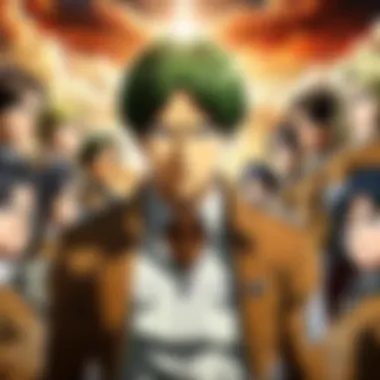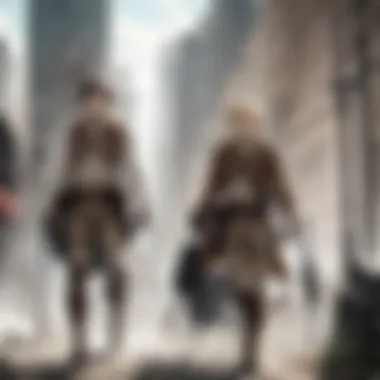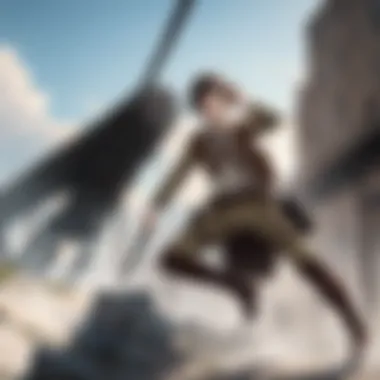In-Depth Review of Attack on Titan Season 4 English Dub


Anime Series Overview
Attack on Titan, or Shingeki no Kyojin, burst onto the anime scene in 2013, captivating audiences with its intense narrative and haunting visuals. This dark fantasy series is set in a world where humanity resides within enormous walled cities to protect themselves from the Titans, giant humanoid creatures that devour humans without reason. As the story unfolds, it delves into themes of freedom, survival, and the existential struggle between humanity and the Titans.
The plot, interwoven with political intrigue and philosophical dilemmas, keeps viewers on the edge of their seats. Key themes that resonate throughout include the loss of innocence, the moral complexities of war, and the quest for identity amidst chaos.
The central characters, such as Eren Yeager, Mikasa Ackerman, and Armin Arlert, experience profound transformations as the story progresses. Eren, who starts as a passionate youth filled with rage against the Titans, evolves into a complicated figure grappling with his newfound powers and the consequences of his actions.
The Attack on Titan animation style is striking, characterized by its fluid motion and attention to detail, especially in depicting the Titans and the frenetic battles between them and humans. The soundtrack, composed by Hiroyuki Sawano, is an emotional powerhouse that enhances the gravity of the scenes. Notable episodes include the intense *
Prelims to Attack on Titan
The world of anime has many standout series, but few leave as profound an impact as Attack on Titan. This section delves into the foundational aspects of the series, laying the groundwork for our exploration of its fourth and final season's English dub. Understanding Attack on Titan not only enriches viewers’ appreciation of the narrative but also heightens their awareness of the cultural and thematic complexities at play.
Overview of the Series
Attack on Titan first graced our screens in 2013, rapidly capturing the hearts and minds of audiences worldwide. Adapted from Hajime Isayama's manga, it presents a grim universe where humanity is on the brink of extinction, besieged by gigantic humanoid creatures known as Titans. The series is not just an action-adventure; it's a meticulous study of human nature, societal structures, and moral dilemmas.
As the story unfolds, characters face harrowing choices that resonate with viewers, making each episode feel like a pulse check on humanity's darkest instincts. The art direction complements this intensity with stark visuals, creating an atmosphere that lingers long after watching. The efficiency in storytelling, character development, and emotional weight contributes to its acclaim, making it a critical darling and a fan favorite.
The Significance of the Final Season
The final season of Attack on Titan carries a weighty significance. It's the culmination of years of intricate world-building and character arcs that fans have followed passionately. As the plot thickens, themes of revenge, freedom, and the cyclical nature of conflict come to the forefront. The final season's importance is twofold.
First, it serves as a resolution to the characters’ tumultuous journeys, offering both closure and new questions. The narrative takes sharp turns that challenge not just the heroes but the audience's moral compass.
Secondly, the final season has become a cornerstone of modern anime culture. As dubbing opens the series to a broader audience, discussions regarding its themes transcend language barriers. The English dub facilitates these conversations, providing a platform for analyses that might otherwise be lost in translation. Ultimately, the final season of Attack on Titan isn’t just a farewell; it’s a dialogue about humanity’s choices framed in a richly constructed narrative.
Understanding Dubbing in Anime
Dubbing is a crucial aspect of making anime accessible to a broader audience, especially for those who may not be fluent in Japanese. When it comes to Attack on Titan, the English dub has a significant role, bridging cultural gaps and enhancing the viewing experience for English speakers. Understanding the nuances of dubbing provides insight into how voice performances can alter perceptions of characters and story.
In essence, dubbing involves replacing the original audio track with a new one in the target language. The process has many layers and requires careful consideration of not only linguistic translation but also emotional delivery and lip-syncing. This is not just a matter of translating the words; it's about transferring the sentiments and intent of the original dialogue while resonating with the new audience's cultural context.
The Dubbing Process
The adventure of dubbing starts with script adaptation. Voice directors work closely with translators to ensure that the dialogue fits the context of the scenes while also aligning with the characters' personalities. This phase often involves making choices about how to convey humor, emotion, and action.
Once the script is locked in, casting comes into play. Directors often seek out voice actors who can bring new life to the characters while honoring the originals. The chosen actors then step into the studio for the voice recording sessions. The performance needs to match the original animation as closely as possible, requiring precise timing and matching to the character's mouth movements. Most dubbing studios are equipped with advanced audio technology to ensure high-quality sound production, further elevating the viewer's experience.
"Dubbing is more than just voiceover; it’s about creating a connection with the audience through compelling performances."


Challenges Faced by Voice Actors
Dubbing presents various challenges, notably in the realm of emotional delivery. Voice actors often face the daunting task of conveying the depth of emotion expressed by their Japanese counterparts. To accomplish this, they need to immerse themselves in the character, fully understanding the context of each scene. This can be particularly taxing when the character experiences drastic shifts in emotion or intense moments.
Some common hurdles include:
- Cultural Nuances: Not all idioms or phrases directly translate well, and voice actors must sometimes adapt lines to make sense for English-speaking audiences.
- Character Consistency: In ongoing series, maintaining a consistent vocal performance while the character evolves can be a significant challenge.
- Studio Environment: Recording can be sometimes awkward or stressful. Voice actors need to deliver their best performance while trying to match the energy of the original cast.
Through their hard work and talent, voice actors play an integral role in the success of an anime’s localization. Without their dedication and versatility, many beloved series would not resonate as deeply with fans in non-Japanese speaking regions.
Casting Decisions for Season
Casting decisions in anime, particularly for a significant show like Attack on Titan, carry immense weight. In the case of Season 4, the choices made reflect a delicate interplay between audience expectations and the artistic vision of the directors. Creatively, the right voice can bring a character to life, allowing fans to forge deeper connections with them. Conversely, a poor fit might lead to discontent among viewers. In an adaptation, securing a robust voice cast can enhance the emotional resonance of the story, pivotal in an intricate narrative like this one.
Key Voice Actors and Their Roles
Season 4 of Attack on Titan showcased a mix of returning voice actors and newcomers, each contributing uniquely to their respective characters. For instance, Bryce Papenbrook reprised his role as Eren Yeager, channeling a fierce intensity that matches his character's evolution throughout the season. This continuity allows long-time fans to feel a sense of familiarity yet also observes Eren’s growth in a fresh light.
In contrast, new faces like Ian Sinclair, who voiced Zeke Yeager, brought a different dynamic to the series. Sinclair's performance straddles the line between charisma and danger, perfectly encapsulating Zeke's complex persona. The decision to cast an actor who could convey both warmth and threat is akin to placing the final piece in a puzzle — everything clicks together, enhancing the overall narrative.
Moreover, the seamless integration of these voice talents leads to a richer experience for the audience. It's evident that great thought went into pairing voices with the underlying traits of characters, creating a harmonic balance that serves the show's themes.
The Impact of Veteran Voices
The use of veteran voice actors in Season 4 brought not just skill but a wealth of experience that significantly shaped the series' portrayal. Talents like Laura Bailey, who voiced Historia Reiss, added layers of depth to their characters. Their historical presence in other acclaimed works allowed them to pull from a vast repertoire, distinguishing their portrayals in the vocal landscape of Attack on Titan.
Additionally, the effectiveness of the veteran cast lies in their ability to infuse authenticity into their roles. Their performances often come loaded with nuances that stem from years of practice, resulting in a heightened authenticity that can resonate powerfully with viewers. Such actors tend to understand the emotional landscape of their characters, anticipating how their voice can elevate the narrative moments, making even subtext feel palpable.
"The voices we hear create an echo that lingers long after the final credits roll; they shape our understanding of the characters we have grown to love."
In summary, the casting decisions made for Attack on Titan Season 4 were not merely procedural but pivotal in sculpting the viewing experience. From selecting key voice actors to leveraging the veteran presence for maximum impact, these choices echo throughout the series, leaving lasting impressions on both the narrative and audience.
Thematic Depth of Season
In the final stretch of Attack on Titan, Season 4 takes a bold leap into the murky waters of moral complexity and introspection, presenting viewers with themes that are at once captivating and thought-provoking. This depth is pivotal to understanding how the series has evolved and how it connects with audiences on both emotional and intellectual levels. By probing into the darker corners of human nature, the show sheds light on pivotal questions concerning identity, loyalty, and the lengths one may go for freedom. Such thematic richness serves not just as entertainment, but as a lens through which the viewers can examine their own beliefs and the world around them.
Exploration of Moral Ambiguity
One of the standout features of Season 4 is its astute engagement with moral ambiguity. The show presents characters who are not simply heroes or villains, but multifaceted individuals caught in a web of choice, driven by circumstances and personal beliefs. For instance, the character arcs of Eren Yeager and Reiner Braun showcase this tension. Eren’s transformation into a figure of controversy challenges viewers to grapple with their feelings about what makes someone a hero or a monster.
"The true enemy is not the Titans, but the cycle of hatred that binds us all."
As the narrative unfolds, traditional notions of good and evil are blurred. No longer are characters defined by a single trait or decision; instead, backgrounds and motivations come into play, presenting a layered understanding of conflict. This complexity prompts viewers to reflect on their judgments, pushing them to think critically about the actions of the characters and the broader implications for society.


This thematic exploration is significant for the narrative structure of the season. It invites discussions not just within the story but also among fans, creating dialogues that extend beyond the screen. Themes such as betrayal and redemption are interwoven, influencing how viewers connect with the characters and shaping their emotional responses.
Symbolism and Imagery
Symbolism is another key facet of Season 4, effectively enhancing the storytelling by embedding deeper meanings within the visuals and plots. The use of stark imagery delivers profound truths about the human experience. For instance, the recurring motif of walls serves not just as a literal boundary, but as a metaphor for isolation, fear, and the barriers we construct in our own lives.
Examining elements like the Titans themselves, they are not merely beasts to be defeated but represent humanity’s darkest fears—ignorance, hatred, and the capacity for violence. This layered symbolism enriches the viewer's comprehension, encouraging them to look beyond the immediate narrative.
Furthermore, the contrast of light and dark throughout the season often reflects characters' internal struggles. The use of color and shadow tells stories of despair and hope, illuminating the complex emotional landscape that defines this concluding chapter.
In essence, the richness of imagery underscores the deeper themes laid out in the narrative. This dual focus on moral ambiguity and symbolism creates a tapestry that not only tells a story but invites the audience to ponder and engage with it at a sophisticated level. The thematic depth of Season 4 stands as a testament to the series' commitment to pushing boundaries and asking tough questions, thereby solidifying its place in the pantheon of modern anime.
Audience Reception of the English Dub
In discussing the audience reception of the English dub of Attack on Titan Season 4, it’s essential to understand how adaptations shape the overall experience for fans. It's not just about translating dialogue from Japanese to English; it’s about capturing the essence of the characters, emotion, and story arcs that have resonated with viewers globally. The reception of any dubbed series can reveal much about cultural nuances, audience expectations, and the effectiveness of vocal performances. Understanding this reception can provide greater insight into how the series performs on an international level and its impact on anime consumption.
Critical Acclaim vs. Viewer Opinions
There’s a fine line between critical acclaim and the sentiments expressed by everyday viewers when it comes to anime dubs. The English dub of Attack on Titan Season 4 has garnered mixed reactions among critics and fans alike.
- Critical acclaim generally reflects a well-crafted adaptation, focusing on aspects like voice modulation and emotional delivery. Critics often praise the voice actors for their ability to breathe life into characters, especially during intense scenes. For example, the portrayal of Eren Yeager by Bryce Papenbrook has been highlighted for its depth during critical moments, showcasing vulnerability and rage convincingly.
- On the other hand, viewer opinions can vary significantly from the critics’ perspective. Many fans express dissatisfaction with certain choices. Some may contend that particular characters do not sound as they envisioned them in the original Japanese, leading to a disconnect in the viewer's experience. A vocal segment of the anime community would argue that while the dubbing achieves technical excellence, it may lack the raw emotion found in the original performances.
"Dubbing isn't just about swapping languages. It’s about preserving the soul of the show. If that gets lost, fans really feel it."
Comparative Analysis with Subtitled Versions
When placing the English dub alongside its subtitled counterpart, differences emerge that are interesting to explore.
- Dialogue Nuances: Subtitled versions tend to preserve the exact script written by the creators. This can retain original humor, idioms, or cultural references that might get lost in translation during dubbing. In contrast, dubbed versions often adapt phrases for a Western audience. This may lead to some nuances being altered for localization.
- Character Dynamics: The voice acting in both versions plays a crucial role in how characters are perceived. Some viewers enjoy the crafted nature of the English dub but may miss the authenticity in Japanese voices that convey distinct personality traits.
- Pacing and Timing: Dubs can alter the pacing of scenes. For instance, a scene might flow differently when the timing adjusts for English dialogue. Viewers commonly report differing emotional impacts due to varying delivery speeds in subtitles versus dubbed speaking.
Ultimately, while both versions offer unique experiences, fans should engage with both to fully appreciate the storytelling magic of Attack on Titan. Engaging with both formats highlights how different cultural approaches to voice and language bring various aspects of the narrative to life, showing how Attack on Titan transcends boundaries in storytelling.
Cultural Impact of the Dub
The cultural resonance of the English dub of Attack on Titan Season 4 highlights how localization plays a pivotal role in making this anime accessible and relatable to a broader audience. The adaptation isn't just a translation of words; it transcends that by weaving in nuanced cultural references, idioms, and dialogues that resonate with English-speaking audiences. This process fosters a deeper connection between the content and its viewers, enriching the experience and sustaining interest in the series among diverse cultural backgrounds.
Global Reception and Influence
The global reception of the English dub has been overwhelmingly positive, with viewers often praising the voice casting choices and fidelity to the original material. This reaction showcases the meticulous effort put into selecting voice actors who embody the characters’ essence. For instance, the portrayal of Eren Yeager by Bryce Papenbrook encapsulates the character’s evolution in a manner that feels authentic and compelling. Many viewers express through forums and social media platforms like Reddit that they prefer the dub for its delivery and emotional weight, proving that the voices behind the characters can influence perceptions and attachment in significant ways.
Moreover, this dub has sparked conversations outside the anime community, stirring curiosity and reaching an audience that might otherwise overlook subtitles. It plays a crucial role in promoting anime culture in the West, as those who enjoy Attack on Titan often share their opinions and recommendations with friends and family, thus boosting viewership and influence.
"Dubbing transforms the experience, opening doors for those who might find subtitles daunting. It’s not just about watching; it’s about connecting."


Dubbing as a Means of Localization
Dubbing serves as a crucial means of localization, translating cultural nuances that subtitles sometimes can’t capture. Beyond direct translations, the process can involve adapting cultural references to make them relatable for an English-speaking audience. For example, food references or idiomatic expressions that are commonplace in Japanese culture may not have an equivalent in English. Here, voice directors and scriptwriters take creative liberties, ensuring that the essence of dialogues remains intact while adapting them for comprehension.
Moreover, the sound quality and performance of voice actors significantly elevate the overall viewing experience. Well-executed dubbing can lead to enhanced emotional engagement, making viewers laugh, cry, or feel tense right alongside the characters.
In summary, the English dub of Attack on Titan Season 4 not only propels the narrative across language barriers but also enriches cultural appreciation, allowing fans to experience the highs and lows in a manner that feels immediate and relatable. It fosters inclusivity, bridging gaps between cultures and promoting global dialogue through the shared experience of a beloved series.
Future of Dubbing in Anime
The future of dubbing in anime is a topic of significant relevance, particularly as it correlates with the broader trends in global media consumption. As audiences demand quality content in a language they comprehend, the nuances of dubbing evolve to keep pace. This exploration sheds light on both the technological advancements and emerging trends within the industry that shape how anime is produced for wider audiences.
Trends in the Industry
Anime dubbing is seeing significant shifts, propelled by changing viewer preferences and advancements in media distribution. A few key trends stand out:
- Diversity in Voices: The voice acting industry is gradually shifting towards a more diverse range of casting options. Gone are the days when only a select few voice actors were synonymous with particular characters. Today, studios are embracing voices from various backgrounds to better reflect global demographics.
- Simul-dubbing: There’s been a notable increase in the cross-over between subtitled and dubbed versions, thanks to simul-dubbing, where new episodes are dubbed almost concurrently with their original airings. This trend caters to a growing need for immediacy among international audiences, allowing viewers to discuss and enjoy episodes as they are released.
- Niche Genres: Dubbing has also expanded beyond mainstream anime to include niche genres, such as horror or slice-of-life dramas. This diversification hints at a curiosity-driven strategy among dubbing studios to reach untapped audiences looking for unique narratives. Moreover, platforms like Netflix and Crunchyroll are amplifying the demand for high-quality dubbed content across various genres.
The Role of Technology in Dubbing
In addition to industry trends, technology plays a pivotal role in the evolution of anime dubbing. Here’s how:
- Voice Modulation Software: Technologies that enhance or modify a voice actor’s capabilities are becoming more prevalent. This allows for a broader range of performances, tailoring the dub to sound closer to the original intent of the creators.
- Artificial Intelligence: AI is now being explored in dubbing scripts, where automated systems can analyze original voice intonations and inflections. This aids voice actors in replicating the emotional gravity of a scene more accurately while maintaining the unique feel of the original dialogue.
- Remote Collaboration: In a post-pandemic world, many voice actors have begun working from home studios, utilizing cloud-based technology to collaborate in real-time. This remote setup not only saves costs but also facilitates a much faster production process, bringing dubs to audiences in record time.
In summary, as the anime dubbing industry strides forward, it’s unmistakable that both trends and technology are crucial in shaping how fans across the globe engage with their favorite shows. As we continue to witness these changes unfold, it’s clear that the future of dubbing promises to be as dynamic and impactful as the series it seeks to adapt.
The evolution of dubbing is not merely a reflection of new technologies; it’s a testament to the anime community's evolving tastes and demands.
Audience expectations are poised to further drive these transformations, ensuring that the essence of storytelling remains intact while making content more accessible.
The End
The conclusion of our examination of the English dub for Attack on Titan Season 4 serves not just as a summary, but as a vital reflection on the myriad elements that have contributed to the series' narrative and cultural significance. This section encapsulates the heart of the analysis, illustrating why understanding this adaptation is crucial for fans and newcomers alike.
Reflections on the Series
Reflecting on the journey through Attack on Titan brings to light several critical aspects. The series has evolved significantly since its inception, tackling complex themes such as freedom, sacrifice, and the human condition. In Season 4, the English dub has succeeded in more than mere translation; it’s crafted an immersive experience that resonates with Western audiences. The voice actors, through their authentic performances, have breathed life into characters who grapple with indelible moral dilemmas. Voices such as that of Bryce Papenbrook (Eren Yeager) and others not only carry the weight of the script but channel the emotions that make the series compelling.
Moreover, Attack on Titan has transcended cultural boundaries. The English dub manages to preserve the original tone while adapting dialogue for better resonance with English-speaking viewers. This careful balancing act speaks volumes about the passion behind its production.
Anticipation for Future Installments
Looking ahead, the anticipation surrounding potential new content in the Attack on Titan universe is palpable among fans. There are whispers of spin-offs and prequels that promise to explore the lore and intricacies of this fascinating world. The success of the dub has certainly set a precedent, raising expectations for quality voice work in any future adaptations.
In contemporary anime, trends indicate a shifting landscape where high-caliber dubbing is not just an afterthought but a necessary pillar. Consequently, there is an exciting prospect for how future installments may continue to evolve, perhaps integrating technology into the dubbing process to enhance the viewer experience.
"The world of Attack on Titan is vast and complex, setting the stage for stories yet to be told. Fans can hardly wait to see what unfolds next."
The English dub of Season 4 is just a chapter in an ongoing saga that captivates global audiences. As discussions around the series persist, one can only hope that future adaptations maintain the same level of attention to detail, ensuring that every vocal performance, narrative choice, and emotional beat continues to resonate long after the credits roll.







